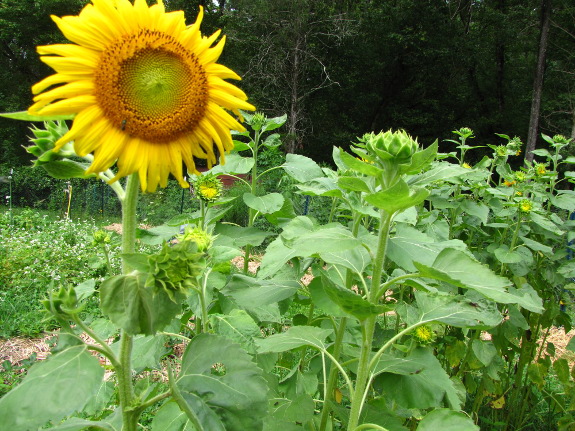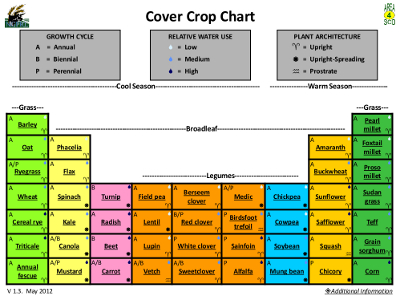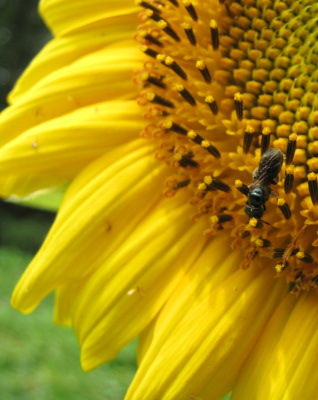
NGPRL's Cover Crop Chart

 For a couple of years now, Managing
Cover Crops Profitably has been my cover crop
bible. But although the publication has great depth, it only
covers 19 species, and I'm starting to get a handle on which of those
will work on our farm and which won't. Being who I am, I'm not
content to rest on my laurels and stick to buckwheat in the summer and oilseed
radishes and oats in the winter --- I want to keep trying
new things!
For a couple of years now, Managing
Cover Crops Profitably has been my cover crop
bible. But although the publication has great depth, it only
covers 19 species, and I'm starting to get a handle on which of those
will work on our farm and which won't. Being who I am, I'm not
content to rest on my laurels and stick to buckwheat in the summer and oilseed
radishes and oats in the winter --- I want to keep trying
new things!
Enter the Northern
Great Plains Research Laboratory's Cover Crop Chart. This publication
replaces depth with breadth, presenting the highlights of 46 cover crop
species both pictorially and in the form of a bulleted list.
That's the source I headed toward when I started hearing about
sunflowers used as a cover crop.
 As I already know well,
sunflowers are great for attracting pollinators (and for feeding
chickens), but how
do the plants operate as a cover crop? The Cover
Crop Chart mentions that sunflowers pull up nutrients from deep
in the soil, perhaps because they're good at teaming up with arbuscular
mycorrhizae. Sunflowers' C:N
ratio is listed as
11 to 14 for the leaves, 41 to 46 for the stems, 50 to 68 for the
roots, and 14 to 19 for the flowers. What that data says to me is
that sunflowers are good to plant in troubled soil that's going to be
taking the whole summer off, or in the chickens' winter yard, scratched
bare from last year and needing some high carbon materials (and
playthings) to keep your flock happy this winter.
As I already know well,
sunflowers are great for attracting pollinators (and for feeding
chickens), but how
do the plants operate as a cover crop? The Cover
Crop Chart mentions that sunflowers pull up nutrients from deep
in the soil, perhaps because they're good at teaming up with arbuscular
mycorrhizae. Sunflowers' C:N
ratio is listed as
11 to 14 for the leaves, 41 to 46 for the stems, 50 to 68 for the
roots, and 14 to 19 for the flowers. What that data says to me is
that sunflowers are good to plant in troubled soil that's going to be
taking the whole summer off, or in the chickens' winter yard, scratched
bare from last year and needing some high carbon materials (and
playthings) to keep your flock happy this winter.
I'd be curious to hear
what unusual cover crops our readers have been trying in their
gardens. Be sure to mention your garden conditions and how well
the plants grew in your comment so someone else can learn from your
experience!
Want more in-depth information? Browse through our books.
Or explore more posts by date or by subject.
About us: Anna Hess and Mark Hamilton spent over a decade living self-sufficiently in the mountains of Virginia before moving north to start over from scratch in the foothills of Ohio. They've experimented with permaculture, no-till gardening, trailersteading, home-based microbusinesses and much more, writing about their adventures in both blogs and books.
Want to be notified when new comments are posted on this page? Click on the RSS button after you add a comment to subscribe to the comment feed, or simply check the box beside "email replies to me" while writing your comment.

Phil --- Sounds like you might need to till the cover crops in in the spring, but an interesting mix for cold weather otherwise.
A quick search on the differences between Daikon and oilseed radishes is a bit confusing, so I'm not quite sure who's right. I suspect folks use those common names interchangeably sometimes, and sometimes use them to refer to different subspecies of the same species.
I hope you take photos of your cover crop/deer plot!